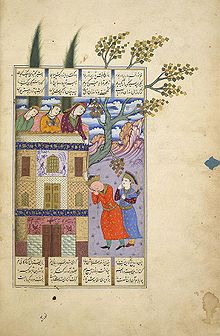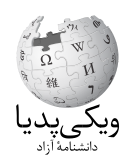
Back Аџьам бызшәа Abkhazian Bahsa Parisi ACE Персыбзэ ADY Persies Afrikaans Persische Sprache ALS ፋርስኛ Amharic Idioma persa AN Persisc sprǣc ANG फारसी भाषा ANP اللغة الفارسية Arabic
| Lingua Persica فارسی (Fārsī)
| ||
|---|---|---|
| IPA: | [ fɒːɾˈsiː ] | |
| Taxinomia: | Lingua Indoeuropaea e divisione Iranica
| |
| Locutores: | sensu stricto circa 23 879 300 anno 1997[1] sensu lato 38 000 000[2]
| |
| Sigla: | 1 fa, 2 per(B), fas(T), 3 pes, prs, tgk | |
| Status publicus | ||
| Officialis | Persia, Afgania, Tadzikistania | |
| Privata | permultae civitates | |
| Litterae: | Litterae Persicae | |
| Scriptura: | Arabica | |
| Procuratio: | Academia Linguae Litterarumque Persicae | |
 Familiae linguisticae coloribus Vicipaedicis pictae | ||
 Collocatio linguae Persicae locutorum | ||




Lingua Persica[3] (Persice پارسی ; IPA [fɒːɾˈsiː]) est lingua Iranica intra ramum Indo-Iranicum linguarum Indo-Europaearum, qua homines praecipue in Irania, Afghania, Tadzikistania, et civitatibus in dicionem culturae Iraniae Maioris olim redactis utuntur. Continuatio Persicae mediae habetur, linguae publicae religionis litterarumque Imperii Sassanidarum, quae vicissim fuit continatio Persicae antiquae, linguae Imperii Persici aevo Achaemenidarum magni momenti.[4][5][6] Lingua Persica est lingua pluricentrica, atque eius grammatica grammaticae multarum linguarum Europae hodiernae similis est.[7]
Inter scriptores litterarum Persicarum recentiorum enumerare oportet poetas Nizāmī, Firdausī, Umar Khayyām, Hafizus, Saadi, Romanus, et Assar Tabrizi.
- ↑ Vide Ethnologue
- ↑ Ethnologue
- ↑ "Lingua Persica": Conradus Gesnerus, Mithridates: de differentiis linguarum (1555) textus f. 63r
- ↑ Gilbert Lazard, "The Rise of the New Persian Language," in The Cambridge History of Iran, ed. R. N. Frye (Cantabrigiae: Cambridge University Press, 1975), 4:595–632: "The language known as New Persian, which usually is called at this period (early Islamic times) by the name of Dari or Farsi-Dari, can be classified linguistically as a continuation of Middle Persian, the official religious and literary language of Sassanian Iran, itself a continuation of Old Persian, the language of the Achaemenids. Unlike the other languages and dialects, ancient and modern, of the Iranian group such as Avestan, Parthian, Soghdian, Kurdish, Balochi, Pashto, etc., Old Persian, Middle and New Persian represent one and the same language at three states of its history. It had its origin in Fars (the true Persian country from the historical point of view) and is differentiated by dialectical features, still easily recognizable from the dialect prevailing in north-western and eastern Iran."
- ↑ Ammon Ulrich, Norbert Dittmar, Klaus J. Mattheier, et Peter Trudgill, "Sociolinguistics Hsk 3/3 Series Volume 3 of Sociolinguistics: An International Handbook of the Science of Language and Society," ed. 2a. (Walter de Gruyter, 2006): "Middle Persian, also called Pahlavi is a direct continuation of old Persian, and was used as the written official language of the country. . . . However, after the Moslem conquest and the collapse of the Sassanids, Arabic became the dominant language of the country and Pahlavi lost its importance, and was gradually replaced by Dari, a variety of Middle Persian, with considerable loan elements from Arabic and Parthian."
- ↑ Prods Oktor Skjærvø (2006), Encyclopedia Iranica. Locus: "Iran, vi. Iranian languages and scripts, "new Persian, is "the descendant of Middle Persian" and has been "official language of Iranian states for centuries", whereas for other non-Persian Iranian languages "close genetic relationships are difficult to establish" between their different (Middle and Modern) stages. Modern Yaḡnōbi belongs to the same dialect group as Sogdian, but is not a direct descendant; Bactrian may be closely related to modern Yidḡa and Munji (Munjāni); and Wakhi (Wāḵi) belongs with Khotanese."
- ↑ Richard Davis, "Persian," in Medieval Islamic Civilization, ed. Josef W. Meri et Jere L. Bacharach (Taylor & Francis, 2006), 602–603: "The grammar of New Persian is similar to many contemporary European languages." Similiter, lexicon Persicum ex Pahlavi deducitur.
© MMXXIII Rich X Search. We shall prevail. All rights reserved. Rich X Search
